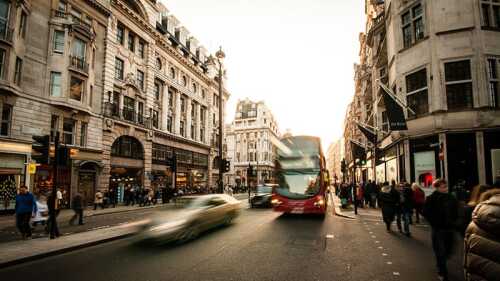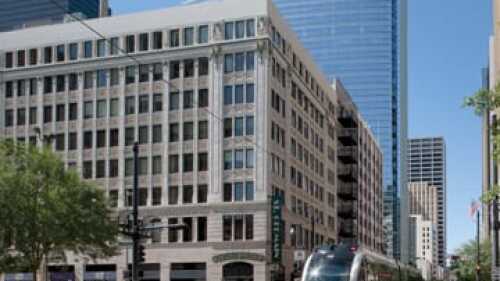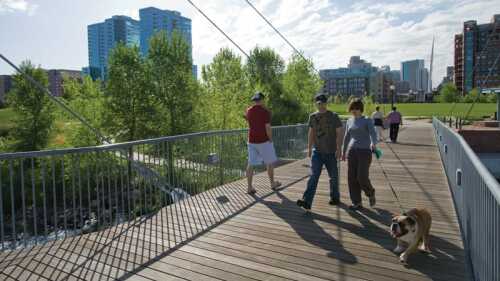San Franciscans assume that one day an earthquake will hit their city hard, thanks to the geologic fault line that runs below it. But G.L. Hodge is not afraid.
Hodge has a knack for being where he is needed during a crisis. During the last big quake to rattle the San Francisco Bay area, back in 1989, he was the manager of a local Kmart store across the bay in the town of Fremont, California. He made sure that his store was one of the first in the area to reopen after the quake, distributing much-needed supplies to the community.
Related: Register for ULI’s Reslience Conference in San Francisco
Two-and-a-half years later, Hodge moved to Los Angeles to manage another Kmart in the economically depressed area known as Compton. When riots broke out after police officers were acquitted in a racially charged beating, his store was one of the few in the neighborhood not to be looted. The National Guard used it as a command center.
“I’ve been dealing with these kinds of situations for a long time,” Hodge says. As a retail store manager, he had to be prepared for anything. Over the years, he also picked up disaster preparedness tips from his wife, a San Francisco firefighter.
More From Citiscope: Judith Rodin on the “resilience dividend” | Resilience is relationships, not just infrastructure
Now retired from retail, Hodge is putting his preparedness ideas to work at Providence Baptist Church of San Francisco, where he serves as administrator. Providence is a humming community hub in an area called the Bayview. Once known as a shipbuilding center, the neighborhood today has more poverty and unemployment than elsewhere in San Francisco. About one-third of the residents are foreign-born and one-third are African American. “It’s a 24-hour church,” says Hodge. He and his staff run a daily after-school program, serve dinner to the community on Wednesday evenings, and operate a food bank each Thursday. Each night, the church’s gymnasium is transformed into a 125-bed homeless shelter.
Those services aren’t too unusual for an American church. What is unusual is that Hodge’s budget at Providence also has a line item for disaster preparedness. The American Red Cross and local nonprofit groups have come together to provide disaster prep training for the congregation, as well as free cardiopulmonary resuscitation (CPR) training for church staff and the public. Hodge keeps a two-way radio in his office, enabling communication with a local command center in the event of a disaster. In his office, he showed me a meticulously prepared kit that includes binders holding disaster protocols, contact information for critical neighborhood volunteers, and Bayview maps identifying caches of potable water and other emergency supplies.
The church building itself is rated to be able to withstand a magnitude 8.0 earthquake. If one hits, the church is expected to become even more of a community hub than it is now. Providence partnered with the Red Cross and the local electric utility to prepare a cache of emergency supplies—food, medicine, fuel, and a backup generator—stored in the parking garage located beneath the senior citizen apartments built adjacent to the church. If necessary, the generator can keep the church, its two kitchens, and the food bank operating for up to five days to provide the community with hot meals and groceries. “Anything that we can do to make sure that people can stay in their homes, feel safe, and create a sense of normalcy in the community,” says Hodge.
Defining a Buzzword
The diligent efforts undertaken at Providence Baptist Church are a grass-roots example of building something that local governments, civic groups, nongovernmental organizations (NGOs), and businesses around the world are talking about a lot these days: resilience.
But that’s a term that means different things to different people.
In the Bay Area, many people understand it in terms of earthquakes, and preparing for “the Big One.” (A quake destroyed the city in 1906; the 1989 quake caused significant damage.) Others see it largely in the context of climate change and preparing for rising sea levels and prolonged droughts like the one California has been suffering through for three years. Some talk of resilience in terms of strengthening at-risk communities, increasing economic opportunity, and decreasing crime. And still others see it as diversifying local economies to protect against housing busts, stock market crashes, and other kinds of economic shocks.
The Bay Area is an important test ground to see weather these various threads can be weaved together across a large metropolitan region. Four Bay Area cities—Alameda, Berkeley, Oakland, and San Francisco—were among the first 33 global cities selected under the Rockefeller Foundation’s 100 Resilient Cities Centennial Challenge. The initiative will provide financial assistance and resources to enable selected cities to develop a resilience plan and hire a “chief resilience officer” to instill this sort of thinking deep into city bureaucracy.
It is no accident that so many Bay Area cities made the cut. Local and regional planning around earthquake risk and climate change has been going on here for years. A report published in March by the Bay Area Joint Policy Committee found that more than 40 cities and counties in the Bay Area have completed climate action plans to reduce greenhouse gas emissions—and a growing number of those plans have added resilience and climate adaptation initiatives. A handful of cities, including Berkeley and San Francisco, have taken an additional step to incorporate climate change risks into their hazard mitigation plans.
Despite these promising first steps, regional experts say that policy makers still must develop a common language about what resilience means. “Resilience is an all-encompassing term,” San Francisco’s Patrick Otellini recently told Green Biz. Otellini was recently named the city’s first—and the world’s first—chief resilience officer. “At some point, it actually becomes such an all-encompassing term that it’s hard to define. It’s not just sustainability. It’s not just seismic safety. It’s not just energy assurance. It’s all of these things together.”
Lessons from Louisiana
The Bayview is a good place to see how this thinking plays out on the ground. While earthquakes may be the most visceral risk, what many people here cite as motivation is a hurricane that struck 2,000 miles (3,200 km) away. It was after Hurricane Katrina hit New Orleans in 2005 that Hodge’s church stepped up its disaster preparedness efforts; many congregants owned property there or had family members affected by the storm and the subsequent flooding.
Katrina also influenced Daniel Homsey, San Francisco’s impassioned director of neighborhood resilience. Homsey went to New Orleans after the hurricane hit to survey damage, offer help, and bring home lessons learned. He is convinced that much of Katrina’s wrath was preventable. Katrina “was a manmade disaster,” Homsey told me. “No one had to die. No one had to even lose their home. It was all a cascading series of really bad decisions, bad planning, and corrupted social capital.”
Homsey had read the work of Harvard University’s Thomas Wooten, whose research on the recovery efforts in New Orleans identified which neighborhoods had bounced back first after Katrina. “It wasn’t education, and it wasn’t income,” he says. “It was neighborhoods that on a daily basis, pre-event, were just working together on problems.”
Homsey realized that “not only do we have to make the investments in our sewer system and [in] strengthening our buildings, we also have to strengthen the residents’ capacity to steward their condition, on a daily basis.” He turned that idea into a city-funded initiative called the Neighborhood Empowerment Network, or NEN. He believed that the way the city interacted with residents was backwards. “Our approach was knight-in-shining-armor: Get out of the way. We know better than you what the problem is. We know better than you what the solution is.”
Homsey decided that the new initiative would operate differently. It would be reflective, not prescriptive. Engaged residents identify neighborhood goals—disaster preparedness and resilience in the Bayview’s case—and NEN provides support to inventory the goals and design ways to achieve them.
In the Bayview, this comes together in the form of an initiative called Resilient Bayview. The project is a community-led planning effort that brings together neighborhood leaders and city agencies to develop and implement a resilience action plan. Four working groups—children and their families; seniors and people living with disabilities; immigrant communities; and small business and nonprofit organizations—meet monthly. The steering committee, of which Hodge is a member, oversees implementation of the action plan.
Committee meetings may sound like a dull response to an existential threat. But as Homsey sees it, having these conversations during normal times is critical to building the neighborhood’s support systems for when disaster strikes. “We have to strengthen the relationships between government and the community, nonprofits, and other agencies,” Homsey says, “and make sure those relationships are full of trust and reciprocity between those who want to help and those who need help.”
Going It Alone
One conclusion that G.L. Hodge and other local leaders have come to in these conversations is that in the event of a disaster, outside help may not arrive for days. “At least three to five days before anyone shows up,” Homsey recalls hearing at a meeting with Resilient Bayview leaders. “Seniors need help within the first couple of hours. We’re it. We are the solution.”
At an early Resilient Bayview meeting, Hodge says, there was much discussion of the federal government’s disaster plan for San Francisco. “That plan is to evacuate the city,” he says. “Our plan is to stay in the city. We aren’t going anywhere. We know that if we work together before a major catastrophe, we will be able to work together during a major catastrophe.” As far as mass evacuation goes, Hodge has taken another lesson from the example of New Orleans: Residents who are forced to leave may never come back.
To bolster the Bayview’s capacity to function independently, NEN is planning to deploy what it calls a neighborhood support center at Providence Baptist Church. “It will activate immediately after an event,” Homsey says. “It will be entirely staffed and managed by the community, for the community. It will be a hyperlocal, problem-solving platform where people can come with immediate issues they need collective support for”—evacuations, medical care, or water delivery.
Much of Resilient Bayview’s early work has focused on making plans to protect the neighborhood’s most vulnerable residents: seniors and the disabled. While residents are determined to stay in their homes after a disaster, these populations have received training on how to evacuate if necessary. Many have received kits that include a sealable plastic bag to stock with prescription medication, cash, and phone numbers for family and friends. They also have door-hangers to help speed up search-and-rescue efforts. One side of the door-hanger is colored red and reads “Need Help”; the other side, colored green, reads “Safely Out.”
In the Bayview, business owner Dan Dodt has floated another idea for seniors that would also turn seismic retrofitting into a job opportunity. Under his “Bayview Bolters” proposal, at-risk youth would be trained by members of the local building trades unions how to bolt down the foundations of seniors’ homes. The young construction workers would be paid with workforce development grant money. “Isn’t it a great double-double?” asks Homsey. “Protecting seniors, preserving housing, and taking youth who are at-risk and giving them a skill, a trade, and, frankly, probably about 100 years’ worth of work in this town.”
For Homsey, such creative thinking is validation of the value of the free exchange of ideas facilitated by the Resilient Bayview partnership. “Residents have been asking a lot of hard questions that we haven’t had great answers for,” he says. “They have been influencing the priorities inside city hall in regard to emergency management and preparedness because, for the first time, we’ve had an organized community where the supervisor is involved, everyone’s plugged in, asking really direct specific questions that frankly have highlighted areas where we need to do more work.”
Hodge also believes that the long hours he and his neighbors have invested in these meetings, conversations, planning sessions, and partnerships have paid off. “Disaster preparedness is something that all of us need to be doing, but it’s not something you need to spend a lot of money to do,” he says. “We’re creating a culture of preparedness. That’s why I’m a part of it.”
Citiscope is a nonprofit news outlet that covers innovations in cities around the world. More at Citiscope.org.




